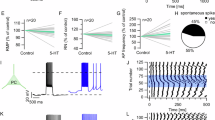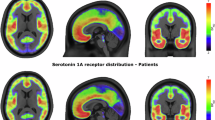Abstract
To elucidate the relative contribution of somatodendritic 5-HT1A autoreceptors and postsynaptic 5-HT1A receptors in the specific anti-aggressive properties of 5-HT1A receptor agonists, the influence of the novel benzodioxopiperazine compound S-15535, which behaves in vivo as a competitive antagonist at postsynaptic 5-HT1A receptors and as an agonist at 5-HT1A autoreceptors, upon offensive and defensive aggression was investigated in wild-type rats using a resident-intruder paradigm. S-15535 exerted a potent dose-dependent decrease in offensive, but not defensive, aggressive behavior (inhibitory dose (ID)50 = 1.11 mg/kg). This anti-aggressive profile was roughly similar to that of the potent pre- and postsynaptic 5-HT1A full agonist alnespirone (ID50 = 1.24). The drug's profound anti-aggressive actions were not accompanied by sedative side effects or signs of the “5-HT1A receptor-mediated behavioral syndrome,” which are characteristically induced by prototypical 5-HT1A receptor agonists like 8-OH-DPAT and buspirone. The selective pre- and postsynaptic 5-HT1A antagonist WAY-100635, which was inactive given alone, abolished the anti-aggressive effects of S-15535 and alnespirone, thereby confirming the involvement of 5-HT1A receptors. Furthermore, combined administration of S-15535 and alnespirone elicited an additive anti-aggressive effect, providing further support for somatodendritic 5-HT1A receptor involvement. Finally, the postsynaptic 5-HT1A antagonistic properties of S-15535 were confirmed by showing blockade of the alnespirone-induced hypothermia, a postsynaptic 5-HT1A mediated response in the rat. These data provide extensive evidence that the anti-aggressive effects of 5-HT1A receptor agonists are expressed via their action on somatodendritic 5-HT1A autoreceptors, thereby most likely attenuating intruder-activated serotonergic neurotransmission.
Similar content being viewed by others
Log in or create a free account to read this content
Gain free access to this article, as well as selected content from this journal and more on nature.com
or
References
Bell R, Hobson H . (1994): 5-HT1A receptor influences on rodent social and agonistic behavior: A review and empirical study. Neurosci Biobehav Rev 18: 325–338
Berman ME, Tracy JI, Coccaro EF . (1997): The serotonin hypothesis of aggression revisited. Clin Psychol Rev 17: 651–665
Blanchard DC, Rodgers RJ, Hendrie CA, Hori K . (1988): Taming of wild rats by 5-HT1A receptor agonists buspirone and gepirone. Pharmacol Biochem Behav 31: 269–278
Blier P, de Montigny C . (1998): Possible serotonergic mechanisms underlying the antidepressant and anti-obsessive-compulsive disorder responses. Biol Psychiatry 44: 313–323
Briese E, Cabanac M . (1991): Stress hyperthermia: Physiological arguments that it is a fever. Physiol Behav 49: 1153–1157
Broderick PA, Barr GA, Sharpless NS, Bridger W . (1984): Biogenic amine alterations in limbic brain regions of muricadal rats. Res Comm Chem Pathol Pharmacol 48: 3–15
Broekkamp CLE, Leysen D, Peeters BWMM, Pinder RM . (1995): Prospects for improved antidepressants. J Med Chem 38: 4615–4633
Cadogan AK, Kendall DA, Fink H, Marsden CA . (1994): Social interaction increases 5-HT release and cAMP efflux in the rat ventral hippocampus in vivo. Behav Pharmacol 5: 299–305
Chaput Y, Lesieur P, de Montigny C . (1990): Effects of short-term serotonin depletion on the efficacy of serotonin neurotransmission: Electrophysiological studies in the rat central nervous system. Synapse 6: 328–337
Coplan JD, Wolk SI, Klein DF . (1995): Anxiety and the serotonin1A receptor. In Bloom FE, Kupfer DJ (eds), Psychopharmacology: The Fourth Generation of Progress. New York, Raven Press Ltd, pp 1301–1310
Daruna JH, Kent EW . (1976): Comparison of regional serotonin levels and turnover in brain of naturally high and low aggressive rats. Brain Res 101: 489–501
De Almeida RMN, Lucion AB . (1997): 8-OH-DPAT in the median raphe, dorsal periaqueductal gray and corticomedial amygdala nucleus decreases, but in the medial septal area it can increase maternal aggressive behavior in rats. Psychopharmacology 134: 392–400
de Boer SF, Lesourd M, Mocaër E, Koolhaas JM . (1999): Selective anti-aggressive effects of alnespirone in the resident-intruder test are mediated via 5-HT1A receptors: A comparative pharmacological study with 8-OH-DPAT, ipsapirone, buspirone, eltoprazine and WAY-100635. J Pharmacol Exp Ther 288: 1125–1133
De Vry J . (1995): 5-HT1A receptor agonists: Recent developments and controversial issues. Psychopharmacology 121: 1–26
Fabre V, Boni C, Mocaër E, Lesourd M, Hamon M, Laporte A-M . (1997): [3H]Alnespirone: A novel specific radioligand of 5-HT1A receptors in the rat brain. Eur J Pharmacol 337: 297–308
Flannely KJ, Muraoka MY, Blanchard DC . (1985): Specific anti-aggressive effects of fluprazine hydrochloride. Psychopharmacology 87: 86–89
Fletcher A, Forster EA, Bill DJ, Brown G, Cliffe IA, Hartley JE, Jones DE, McLnachan A, Stanhope KJ, Critchley DJP, Childs KJ, Middlefell VC, Lanfumey L, Corradetti R, Laporte AM, Gozlan H, Hamon M, Dourish CT . (1996): Electrophysiological, biochemical, neurohormonal, and behavioral studies with WAY-100635, a potent, selective and silent 5-HT1A receptor antagonist. Behav Brain Res 73: 337–353
Garris DR, Chamberlain JK, DaVanzo JP . (1984): Histofluorescent identification of indolamine-concentrating brain-loci associated with intraspecies, reflexive biting and locomotor behavior in olfactory-bulbectomized mice. Brain Res 348: 201–203
Haddjeri N, Blier P, de Montigny C . (1998): Long-term antidepressant treatments result in a tonic activation of forebrain 5-HT1A receptors. J Neurosci 18: 10150–10156
Haney M, Noda K, Kream R, Miczek KA . (1990): Regional 5-HT and dopamine activity: sensitivity to amphetamine and aggressive behavior in mice. Aggr Behav 16: 259–270
Jolas T, Schreiber R, Laporte AM, Chastanet M, De Vry J, Glaser T, Adrien J, Hamon M . (1995): Are postsynaptic 5-HT1A receptors involved in the anxiolytic effects of 5-HT1A receptor agonists and in their inhibitory effects on the firing of serotonergic neurons in the rat? J Pharmacol Exp Ther 272: 920–929
Kidd EJ, Haj-Dahmane T, Jolas T, Lanfumey L, Fattacini C-M, Guardiola-Lemaitre B, Gozlan H, Hamon M . (1993): New methoxy-chroman derivatives, 4-[N-(5-methoxy-chroman-3-yl)N-propylamino]butyl-8-azaspiro-(4,5)-decane-7,9-dione [(+)-S-20244] and its enantiomers, (+)-S 20499 and (-)S 20500, with potent agonist properties at central 5-HT1A receptors. J Pharmacol Exp Ther 264: 863–872
Koolhaas JM, Schuurman T, Wiepkema PR . (1980): The organization of intraspecific agonistic behavior in the rat. Progr Neurobiol 15: 247–268
Lindgren T, Kantak KM . (1987): Effects of serotonin receptor agonists and antagonists on offensive aggression in mice. Aggr Behav 13: 87–96
Maes M, Meltzer HY . (1995): The serotonin hypothesis of major depression. In Bloom FE, Kupfer DJ (eds), Psychopharmacology: The Fourth Generation of Progress. New York, Raven Press Ltd, pp 933–944
Mann JJ . (1995): Violence and aggression. In Bloom FE, Kupfer DJ (eds), Psychopharmacology: The Fourth Generation of Progress. New York, Raven Press Ltd, pp 1919–1928
Martin P, Beninger RJ, Hamon M, Puech AJ . (1990): Antidepressant-like action of 8-OH-DPAT, a 5-HT1A agonist in the learned helplessness paradigm: Evidence for a postsynaptic mechanism. Behav Brain Res 38: 135–144
McMillen BA, DaVanzo EA, Scott SM, Song AH . (1988): N-Alkyl-substituted Aryl-Piperazine drugs: Relationship between affinity for serotonin receptors and inhibition of aggression. Drug Dev Res 12: 53–62
Miczek KA, DeBold JF, van Erp AMM . (1994): Neuropharmacological characteristics of individual differences in alcohol effects on aggression in rodents and primates. Behav Pharmacol 5: 407–421
Miczek KA, Weerts EM, Vivian JA, Barros HM . (1995): Aggression, anxiety and vocalizations in animals: GABAA and 5-HT anxiolytics. Psychopharmacology 121: 38–56
Millan MJ, Rivet J-M, Canton H, Lejeune F, Gobert A, Widdowson P, Bervoets K, Brocco M, Peglion J-L . (1993): S 15535: A highly selective benzodioxopiperazine 5-HT1A receptor ligand which acts as an agonist and an antagonist at presynaptic and postsynaptic sites respectively. Eur J Pharmacol 230: 99–102
Millan MJ, Canton H, Gobert A, Lejeune F, Rivet J-M, Bervoets K, Brocco M, Widdowson P, Mennini T, Audinot V, Honore P, Renouard A, Le Marouille-Girardon S, Verriele L, Gressier H, Peglion J-L . (1994): Novel benzodioxopiperazines acting as antagonists at postsynaptic 5-HT1A receptors and as agonists at 5-HT1A autoreceptors: A comparative pharmacological characterzation with proposed 5-HT1A anatagonists. J Pharmacol Exp Ther 268: 337–352
Millan MJ, Hjorth S, Samanin R, Schreiber R, Jaffard R, De Ladonchamps B, Veiga S, Goument B, Peglion J-L, Spedding M, Brocco M . (1997): S 15535, a novel benzodioxopiperazine ligand of serotonin (5-HT)1A receptors. II. Modulation of hippocampal serotonin release in relation to potential anxiolytic properties. J Pharmacol Exp Ther 282: 148–161
Mocaër EM, Lesourd M, de Boer SF, Koolhaas JM . (1996): Anti-aggressive effects of -15535, a novel and selective antagonist at postsynaptic 5-HT1A receptors and agonist at 5-HT1A autoreceptors. Proc Soc Neurosci 22 (1)): 607
Mos J, Olivier B, Poth M, van Oorschot R, van Aken H . (1993): The effects of dorsal raphe administration of eltoprazine, TFMPP, and 8-OH-DPAT on resident-intruder aggression in the rat. Eur J Pharmacol 238: 411–415
Muehlenkamp F, Lucion A, Vogel WH . (1995): Effects of selective serotonergic agonists on aggressive behavior in rats. Pharmacol Biochem Behav 50: 671–674
Newman-Tancredi A, Conte C, Chaput C, Verriele L, Millan MJ . (1997): Agonist and inverse agonist efficacy at human recombinant serotonin 5-HT1A receptors as a function of receptor:G-protein stoichiometry. Neuropharmacology 36: 451–459
Nikulina EM . (1991): Neural control of predatory aggression in wild and domesticated animals. Neurosci Biobehav Rev 15: 545–547
Olivier B, Mos J, Raghoebar M, de Koning P, Mak M . (1994): Serenics. In Jucker E (ed), Progress in Drug Research, Vol. 42. Basel, Birkhauser Verlag, pp 167–308
Olivier B, Mos J, van Oorschot R, Hen R . (1995): Serotonin receptors and animal models of aggressive behavior. Pharmacopsychiatry 28: 80–90
Palacios JM, Pazos A, Hoyer D . (1987): Characterization and mapping of 5-HT1A sites in the brain of animals and man. In Dourish, CT Ahlenius, S Hutson, PH (eds), Brain 5-HT1A Receptors. Chichester, Ellis Horwood, pp 67–81
Palacios JM, Waeber C, Hoyer D, Mengod G . (1990): Distribution of serotonin receptors. Ann NY Acad Sci 600: 36–52
Ratey JJ, Sovner R, Parks A, Rogentine K . (1991): Buspirone treatment of aggression and anxiety in mentally retarded patients: A multiple baseline, placebo lead-in study. J Clin Psychiatry 52: 159–162
Sanchez C, Hyttel J . (1994): Isolation-induced aggression in mice: Effects of 5-HT uptake inhibitors and involvement of postsynaptic 5-HT1A receptors. Eur J Pharmacol 264: 241–247
Schreiber R, De Vry J . (1993): Neuronal circuits involved in the anxiolytic effects of the 5-HT1A receptor agonists 8-OH-DPAT, ipsapirone, and buspirone in the rat. Eur J Pharmacol 249: 341–351
Scott PA, Chou JM, Tang H, Frazer A . (1994): Differential induction of 5-HT1A-mediated responses in vivo by three chemically dissimilar 5-HT1A receptor agonists. J Pharmacol Exp Ther 270: 198–270
Sijbesma H, Schipper J, de Kloet ER, Mos J, van Aken J, Olivier B . (1991): Postsynaptic 5-HT1 receptors and offensive aggression in rats: A combined behavioral and autoradiographic study with eltoprazine. Pharmacol Biochem Behav 38: 447–458
Stahl S . (1994): 5-HT1A receptors and pharmacotherapy. Psychopharmacol Bull 30: 39–43
Tompkins EC, Clemento AJ, Taylor DP, Perhach JL . (1980): Inhibition of aggressive behavior in rhesus monkeys by buspirone. Res Comm Psychol Psych Behav 5: 337–352
Tricklebank MD . (1985): The behavioral response to 5-HT receptor agonists and subtypes of the central 5-HT receptor. Trends Pharmacol Sci 5: 403–407
Acknowledgements
The skillful technical assistance of Mrs. Ewold ter Veld and Auke Meinema in the behavioral observations and animal care is gratefully ackowledged.
Author information
Authors and Affiliations
Rights and permissions
About this article
Cite this article
de Boer, S., Lesourd, M., Mocaër, E. et al. Somatodendritic 5-HT1A Autoreceptors Mediate the Anti-Aggressive Actions of 5-HT1A Receptor Agonists in Rats: An Ethopharmacological Study with S-15535, Alnespirone, and WAY-100635. Neuropsychopharmacol 23, 20–33 (2000). https://doi.org/10.1016/S0893-133X(00)00092-0
Received:
Revised:
Accepted:
Issue date:
DOI: https://doi.org/10.1016/S0893-133X(00)00092-0
Keywords
This article is cited by
-
The role of serotonin in modulating common waxbill behaviour
Behavioral Ecology and Sociobiology (2023)
-
Anti-aggressive effects of the selective high-efficacy ‘biased’ 5-HT1A receptor agonists F15599 and F13714 in male WTG rats
Psychopharmacology (2016)
-
Brain serotonin receptors and transporters: initiation vs. termination of escalated aggression
Psychopharmacology (2011)
-
Social instigation and aggression in postpartum female rats: role of 5-Ht1A and 5-Ht1B receptors in the dorsal raphé nucleus and prefrontal cortex
Psychopharmacology (2011)
-
Involvement of Presynaptic 5-HT1A Receptors in Immunomodulation in Conditions of Psychoemotional Tension
Neuroscience and Behavioral Physiology (2010)



